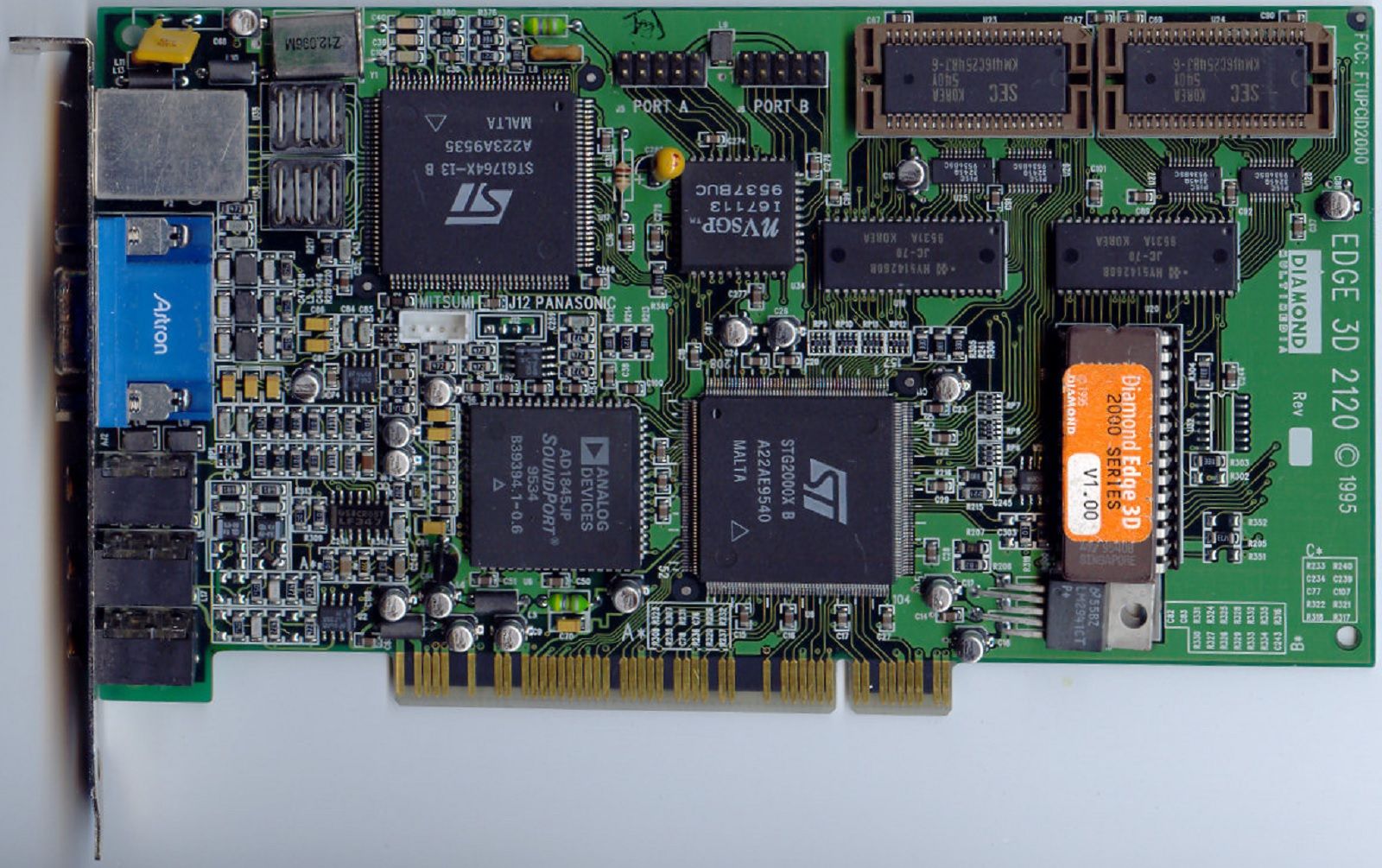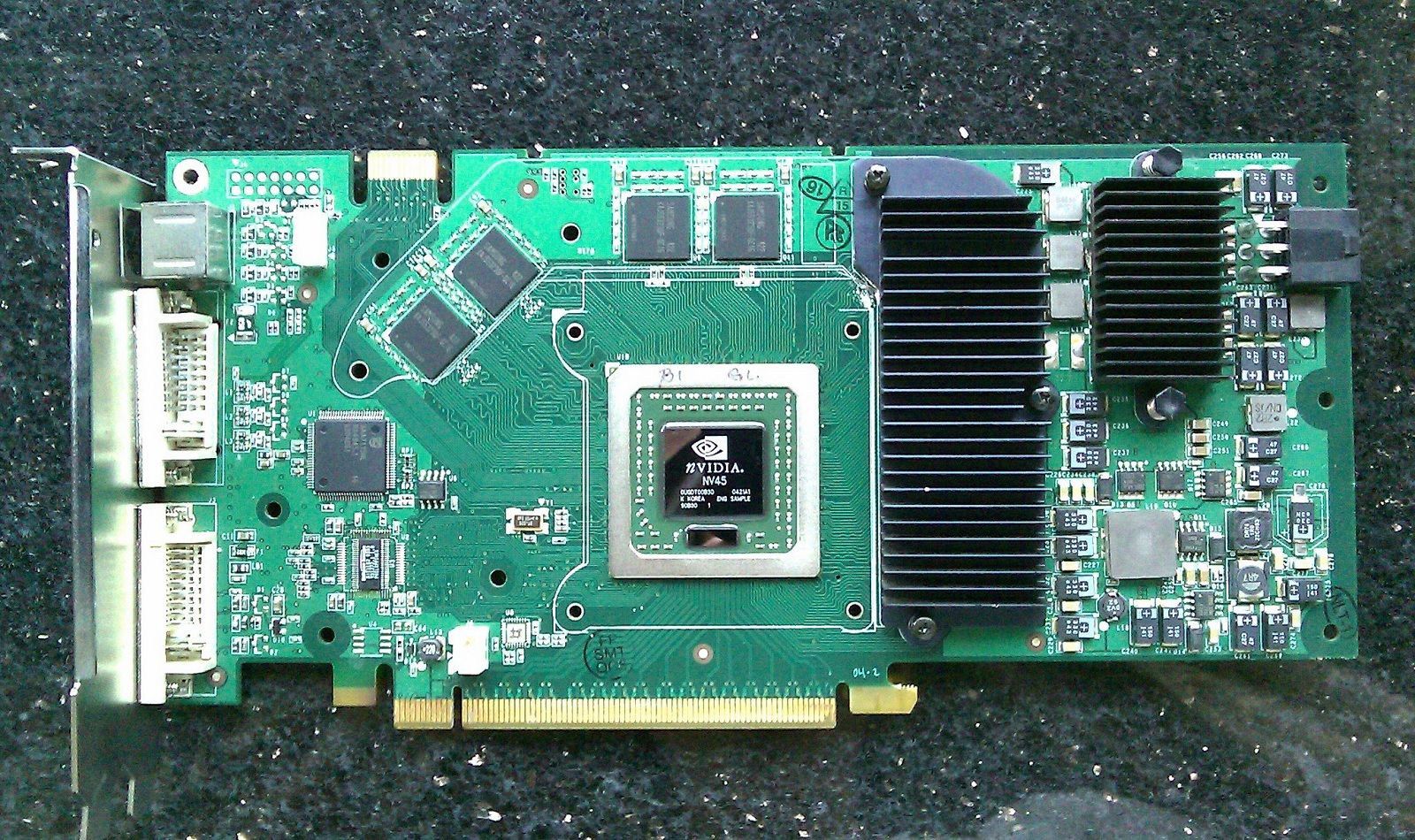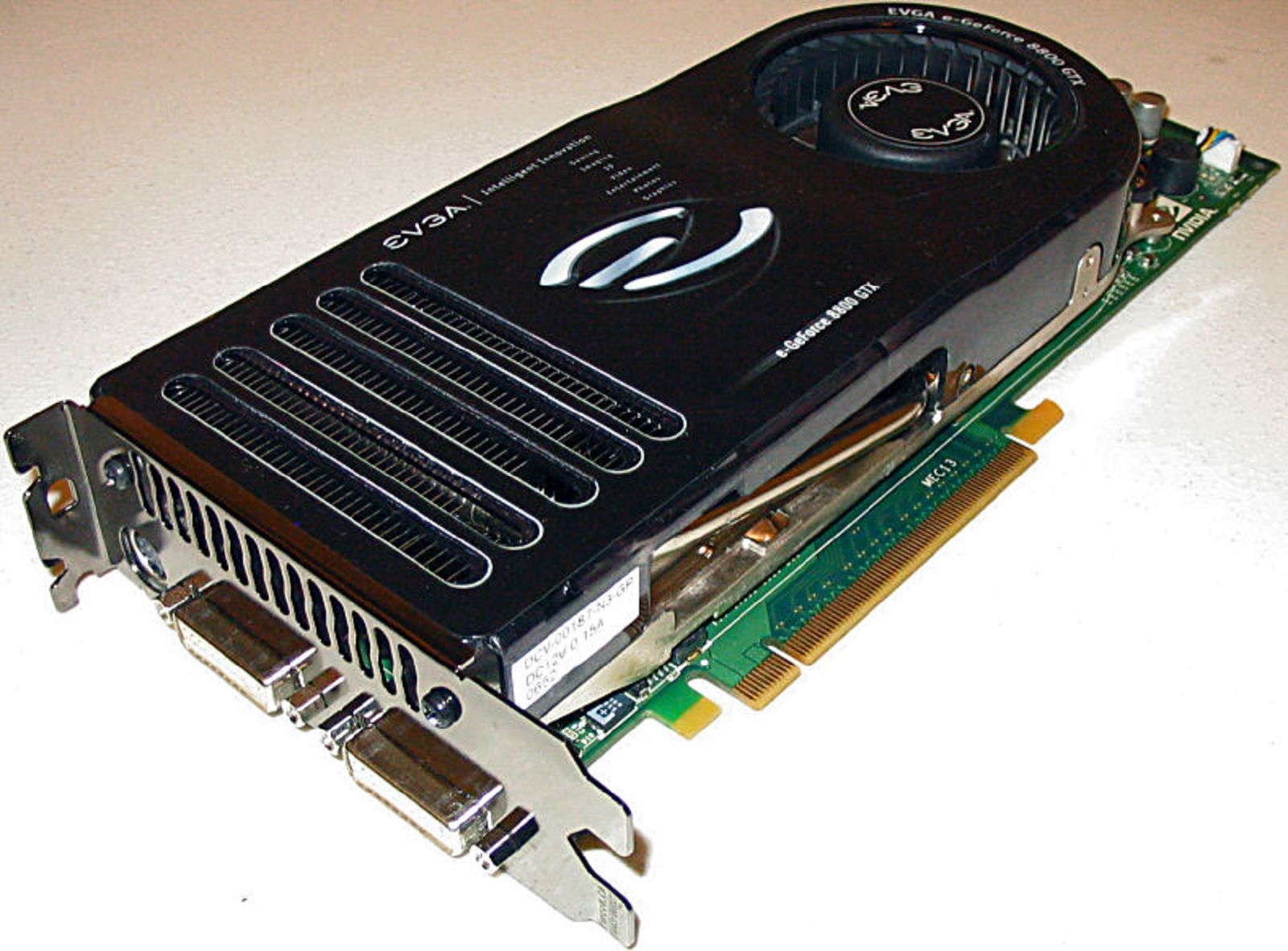注: 机翻,未校。
Nvidia GPUs through the ages: The history of Nvidia’s graphics cards
By Adrian Willings
Updated Mar 25, 2023
Nvidia was originally founded in 1993 but it wasn’t until 1995 that the company released its first graphics product - the NV1.
Nvidia 最初成立于 1993 年,但直到 1995 年,该公司才发布了其第一款图形产品 - NV1。
Things have changed a lot since then and we’re now spoiled with ray tracing, DLSS and other wonderful technologies that make our gaming experiences even more enjoyable.
从那时起,情况发生了很大变化,我们现在被光线追踪、DLSS 和其他出色的技术宠坏了,这些技术让我们的游戏体验更加愉快。
We’re taking a look back through the history of Nvidia graphics cards and what these devices have looked like over the years.
我们正在回顾 Nvidia 显卡的历史以及这些设备多年来的样子。
Nvidia NV1 英伟达 NV1(1995)

Swaaye/Wikipedia
The Nvidia NV1 launched in 1995 and was able to handle both 2D and 3D video. It was sold as the “Diamond Edge 3D” and even sported a Sega Saturn compatible joypad port.
Nvidia NV1 于 1995 年推出,能够处理 2D 和 3D 视频。它以“Diamond Edge 3D”的形式出售,甚至配备了与世嘉土星兼容的操纵手柄端口。
Several Sega Saturn games were ported for PC including Panzer Dragoon and Virtua Fighter Remix. Those features alone weren’t enough to appeal to the market though as the Saturn was struggling to compete with the original PlayStation.
几款世嘉土星游戏被移植到 PC 上,包括 Panzer Dragoon 和 Virtua Fighter Remix。不过,仅靠这些功能不足以吸引市场,因为土星正在努力与原始 PlayStation 竞争。
NV1 was off to a rough start that was made worse by the release of Microsoft DirectX which was incompatible with the GPU and many games would not run.
NV1 的开局并不顺利,但 Microsoft DirectX 的发布使情况变得更糟,它与 GPU 不兼容,许多游戏无法运行。
Nvidia RIVA 128 英伟达 RIVA 128(1997)

Mathías Tabó/Wikipedia
In 1997 Nvidia released the NV3 aka Riva 128, Riva stood for “Real-time Interactive Video and Animation”. This graphics card used both 2D and 3D acceleration along with polygon texture mapping.
1997 年,Nvidia 发布了 NV3 又名 Riva 128,Riva 代表“实时交互式视频和动画”。该显卡同时使用 2D 和 3D 加速以及多边形纹理映射。
At the time Nvidia’s rival 3dfx was dominating the market but the NV3 had a 100MHz core/memory clock and essentially doubled the spec of 3dfx’s Voodoo 1.
当时,Nvidia 的竞争对手 3dfx 在市场上占据主导地位,但 NV3 具有 100MHz 的核心/内存时钟,基本上是 3dfx 的 Voodoo 1 规格的两倍。
There were two variants of the NV3 in the form of the Riva 128 and the Riva 128ZX. The latter was more powerful with 8MB of VRAM and a 250MHz clock speed.
NV3 有两种变体,分别是 Riva 128 和 Riva 128ZX。后者功能更强大,具有 8MB 的 VRAM 和 250MHz 的时钟速度。
The NV3 was much more successful than the company’s first GPU and helped Nvidia get widespread popularity.
NV3 比该公司的第一款 GPU 成功得多,并帮助 Nvidia 获得了广泛的普及。
Nvidia NV4 英伟达 NV4(1998)

Tors/Wikipedia
In 1998, Nvidia unleashed NV4, aka Riva TNT. This graphics card improved over the previous models by including support for 32-bit True Colour. The NV4 also had more RAM with 16MB of SDR SDRAM which meant it offered greater performance too.
1998 年,Nvidia 发布了 NV4,又名 Riva TNT。该显卡比以前的型号有所改进,包括对 32 位 True Color 的支持。NV4 还拥有更多的 RAM 和 16MB 的 SDR SDRAM,这意味着它也提供了更高的性能。
It was around this time that Nvidia started to make moves to regularly update graphics drivers to ensure good performance and compatibility for the end user, something the company is still doing to this day.
大约在这个时候,Nvidia 开始采取行动定期更新图形驱动程序,以确保为最终用户提供良好的性能和兼容性,该公司至今仍在这样做。
Nvidia’s Riva TNT was more affordable at the time than 3dfx’s Vodoo2 if a little slower in terms of performance. The driver support was key to NV4’s success.
Nvidia 的 Riva TNT 当时比 3dfx 的 Vodoo2 更实惠,只是在性能方面稍慢。驱动程序支持是 NV4 成功的关键。
Nvidia NV5 英伟达 NV5(1999)

Uwe Hermann/Wikipedia
In 1999, Nvidia followed up NV4 with the RIVA TNT2. NV5, as it was codenamed, bought a number of updates including 32-bit Z-buffer/stencil support, up to 32MB of VRAM and 2048 x 2048 texture support.
1999 年,Nvidia 在 NV4 之后推出了 Riva TNT2。NV5 的代号为它购买了许多更新,包括 32 位 Z 缓冲区/模板支持、高达 32MB 的 VRAM 和 2048 x 2048 纹理支持。
More importantly, this graphics card had improved clock speeds (up to 150+ MHz) which gave it as much as a 17 per cent performance boost over the previous model.
更重要的是,这款显卡的时钟速度有所提高(高达 150+ MHz),这使其性能比以前的型号提高了 17%。
This card was a direct competitor to the 3dfx Voodoo3 and both were incredibly popular.
这张牌是 3dfx Voodoo3 的直接竞争对手,而且两者都非常受欢迎。
Nvidia GeForce 256 英伟达 GeForce 256(1999)

Hyins/Wikipedia
Late in 1999, Nvidia released what it pitched as the “world’s first GPU” in the form of the Nvidia GeForce 256.
1999 年底,Nvidia 以 Nvidia GeForce 256 的形式发布了它所宣传的“世界上第一款 GPU”。
This was a clever marketing move from Nvidia and the beginning of a love affair with GeForce-branded graphics cards for years to come.
这是 Nvidia 的聪明营销举措,也是未来几年对 GeForce 品牌显卡的热爱的开始。
It improved upon previous RIVA cards by increasing the pixel pipelines but also offered a big leap in performance for PC gaming.
它通过增加像素管道改进了以前的 RIVA 卡,但也为 PC 游戏的性能提供了巨大的飞跃。
This card supported up to 64MB of DDR SDRAM and operated up to 166MHz. As such it was 50 per cent faster than the NV5.
该卡支持高达 64MB 的 DDR SDRAM,运行频率高达 166MHz。因此,它比 NV5 快 50%。
More importantly, the GeForce 256 also fully supported Direct3D 7 which meant it could power many of the best PC games available at the time.
更重要的是,GeForce 256 还完全支持 Direct3D 7,这意味着它可以为当时许多最好的 PC 游戏提供支持。
Shortly after this launch 3dfx went bankrupt and ATI became Nvidia’s main competitor.
此次发布后不久,3dfx 破产,ATI 成为 Nvidia 的主要竞争对手。
Nvidia GeForce2 英伟达 GeForce2(2000)

Hyins/Wikipedia
Nvidia followed up the world’s first GPU with the aptly named GeForce2.
Nvidia 紧随世界上第一个 GPU,推出了恰如其分的 GeForce2。
This GPU came in several different variants including the Ti, Pro, GTS and Ultra models. These were essentially NV11, 15 and 16 cards. Increasing pipelines and higher clock rates followed throughout the 2000 and 2001 releases.
该 GPU 有几种不同的变体,包括 Ti、Pro、GTS 和 Ultra 型号。这些基本上是 NV11、15 和 16 卡。在整个 2000 年和 2001 年版本中,不断增加的管道和更高的时钟速率随之而来。
The thing that made GeForce2 interesting was the start of support for multi-monitor setups.
让 GeForce2 感兴趣的是它开始支持多显示器设置。
It was also around this time that Nvidia acquired 3dfx.
也是在这个时候,Nvidia 收购了 3dfx。
Nvidia GeForce3 英伟达 GeForce3

Hyins/Wikipedia
Shortly after GeForce2 came GeForce3. Codenamed NV20, this series of graphics cards represented Nvidia’s first DirectX 8 compatible GPUs.
在 GeForce2 之后不久,GeForce3 问世。代号为 NV20 的该系列显卡代表了 Nvidia 的第一款兼容 DirectX 8 的 GPU。
There were three versions - the GeForce3, GeForce3 Ti 200, and GeForce3 Ti 500. This next GeForce GPU added programmable pixel and vertex shaders, multisample anti-aliasing into the mix.
有三个版本 - GeForce3、GeForce3 Ti 200 和 GeForce3 Ti 500。下一个 GeForce GPU 添加了可编程像素和顶点着色器,以及多重采样抗锯齿。
A version of GeForce3 referred to as NV2A was used in the original Xbox console.
原始 Xbox 控制台中使用了称为 NV2A 的 GeForce3 版本。
Nvidia GeForce FX series Nvidia GeForce FX 系列(2003)

Hyins/Wikipedia
Leap forward a couple of generations and in 2003 we have the release of Nvidia’s GeForce FX series.
向前飞进了几代,在 2003 年,我们发布了 Nvidia 的 GeForce FX 系列。
These were the fifth generation of the GeForce graphics cards and supported Direct3D 9 as well as a number of new memory technologies. Those included DDR2, GDDR2 and GDDR3 as well as Nvidia’s first attempt at a memory data bus wider than 128 bits.
这些是第五代 GeForce 显卡,支持 Direct3D 9 以及许多新的内存技术。其中包括 DDR2、GDDR2 和 GDDR3 以及 Nvidia 首次尝试超过 128 位的内存数据总线。
Meanwhile, the GeForce FX 5800 made waves for being the first GPU to be equipped with a large cooler. One so big that it was often called the “dustbuster” because of the amount of fan noise it gave off.
与此同时,GeForce FX 5800 成为第一款配备大型散热器的 GPU,掀起了波澜。一个如此之大,以至于它通常被称为“dustbuster”,因为它发出的风扇噪音量很大。
Nvidia GeForce 6 series Nvidia GeForce 6 系列(2004)

Hyins/Wikipedia
Shortly after the release of the GeForce FX series came the 6 series (aka NV40). GeForce 6 was the start of Nvidia pushing SLI technology allowing people to combine more than one graphics card for more power.
GeForce FX 系列发布后不久,6 系列(又名 NV40)问世。GeForce 6 是 Nvidia 推动 SLI 技术的开始,该技术允许人们组合多个显卡以获得更多功能。
The flagship of this range was the GeForce 6800 Ultra, a graphics card which boasted 222 million transistors, 16-pixel superscalar pipelines and six vertex shaders. It had Shader Model 3.0 support and was compliant with both Microsoft DirectX 9.0c and OpenGL 2.0.
该系列的旗舰产品是 GeForce 6800 Ultra,这款显卡拥有 2.22 亿个晶体管、16 像素超标量管道和 6 个顶点着色器。它支持 Shader Model 3.0,并且兼容 Microsoft DirectX 9.0c 和 OpenGL 2.0。
The series also featured Nvidia PureVideo technology and was able to decode H.264, VC-1, WMV and MPEG-2 videos with reduced CPU use.
该系列还采用了 Nvidia PureVideo 技术,能够解码 H.264、VC-1、WMV 和 MPEG-2 视频,同时降低 CPU 使用率。
As a result of all this, the GeForce 6 series was highly successful.
由于这一切,GeForce 6 系列取得了巨大的成功。
Nvidia GeForce7 series Nvidia GeForce7 系列(2005)

FxJ/Wikipedia
In 2005 came the GeForce7 series including the highlight thought of 7800 GTX.
2005 年推出了 GeForce7 系列,其中包括 7800 GTX 的亮点。
That card alone was a real powerhouse for the time and with some clever cooling, Nvidia was able to push the clock speed to 550MHz. At the same time, the company also managed to reduce latency and increase the bus to 512 bit.
仅那张卡在当时就是一个真正的强者,通过一些巧妙的冷却,Nvidia 能够将时钟速度推高到 550MHz。同时,该公司还设法降低了延迟并将总线增加到 512 位。
Interestingly a version of the 7 series was crafted as the RSX Reality Synthesizer which was the proprietary CPU co-created by Nvidia and Sony for the PlayStation 3.
有趣的是,7 系列的一个版本被制作为 RSX Reality Synthesizer,这是 Nvidia 和 Sony 为 PlayStation 3 共同创建的专有 CPU。
Nvidia GeForce8 series Nvidia GeForce8 系列(2006)

Shooke/Wikipedia
In 2006 Nvidia released the GeForce8 series and unveiled its Tesla microarchitecture. This was the company’s first unified shader design and would be one of its most used architectures in future cards too.
2006 年,Nvidia 发布了 GeForce8 系列,并推出了其 Tesla 微架构。这是该公司的第一个统一着色器设计,也将成为其未来显卡中使用最多的架构之一。
The much-loved Nvidia GeForce 8800 GTX was the flagship of the range and was incredibly popular. It boasted 681 million transistors, had 768MB of GDDR3 memory and came with 128 shaders clocked at 575MHz.
备受喜爱的 Nvidia GeForce 8800 GTX 是该系列的旗舰产品,非常受欢迎。它拥有 6.81 亿个晶体管,拥有 768MB 的 GDDR3 内存,并配备了 128 个主频为 575MHz 的着色器。
Most significantly, this graphics card could run Crysis, which was all that PC gamers wanted at the time.
最重要的是,这款显卡可以运行 Crysis,这就是当时 PC 游戏玩家想要的。
In 2006 things were also heating up as AMD purchased ATI for $5.4 billion and would become a thorn in Nvidia’s side for years to come.
2006 年,随着 AMD 以 54 亿美元的价格收购了 ATI,事情也开始升温,并将成为 Nvidia 未来几年的眼中钉。
Nvidia GeForce9 series Nvidia GeForce9 系列(2008)

Sk/Wikipedia
At the start of 2008 Nvidia released the GeForce9 series. These cards continued to use the Tesla architecture but also added PCIe 2.0 support, improved colour and z-compression too.
2008 年初,Nvidia 发布了 GeForce9 系列。这些卡继续使用 Tesla 架构,但也增加了 PCIe 2.0 支持、改进的色彩和 z 压缩。
By this time Nvidia was pushing performance up a notch with clock speeds hitting up to 675MHz and yet power consumption was being reduced as well.
此时,Nvidia 将性能提升了一个档次,时钟速度达到 675MHz,但功耗也得到了降低。








 最低0.47元/天 解锁文章
最低0.47元/天 解锁文章

















 4922
4922

 被折叠的 条评论
为什么被折叠?
被折叠的 条评论
为什么被折叠?








